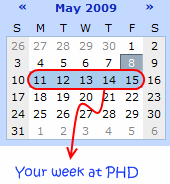 That is right. Next week is your week on this blog. I will post content that is shared by you. So go ahead and share your tips and tricks with us.
That is right. Next week is your week on this blog. I will post content that is shared by you. So go ahead and share your tips and tricks with us.
It is a great way to interact with the community at PHD and give a little back. I didnt know cell from pivot in 2006, but when I started blogging, just by sharing the little I know I ended up learning a lot. It is such a joyful experience and I want you to feel it too.
How can you share your tips?
We have set up a google web form to capture all your tips: click here to submit your tips for your week at PHD
Alternatively you can comment on this post with your tip, or email me at chandoo . d@ gmail.com with your tip.
Make sure you indicate your name, email, website / blog url and the tip in the email.
What are the themes around which you can submit the tips?
You can submit tips on,
- Excel formulas
- Excel Charting
- Shortcuts and Productivity
- Formatting, Printing etc.
- Using Excel – Rest of the stuff
What happens to the submitted tips?
Next week (between 11th and 15th May) everyday I will share all the tips submitted by you with the entire community at PHD. That is almost 5000 people (3500 using RSS and another 1500 regulars at website) waiting to read what you have got to say.
Go!





















7 Responses to “CP014: How to create awesome dashboards – 10 step process for you”
Very interested in topic unfortunately I get no sound when I play it.
Where can I get add ins for excel 2007
#Budala
Try using Google to search for Excel Addin
I would like to join your email newsletter.
@Andy
Goto: http://chandoo.org/wp/
The newletter registration is top Right corner
Hello Chandoo,
i am one of the great fan of your. i am one MIS executive in realstate company.And i try make dash board for CRM(Client Relation Management) Dept formance and anlysis process.Its get created not so effective according to can u suggest me .what i hve to give or take for makeing it for effective and attractive?.
regards,
Shashak verma
Hi,
I want to create an interactive dashboard in excel (Google Drive) which should have multiple data along with beautiful charts..
I handle two teams in IT Tech support so were preparing 2 different dashboards.. however need to club and want to create single report, can anyone help something like